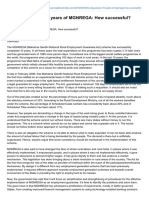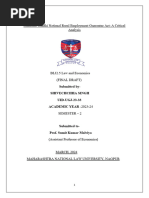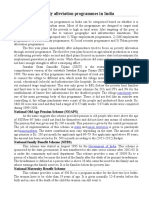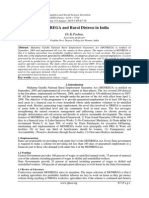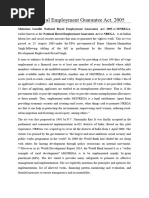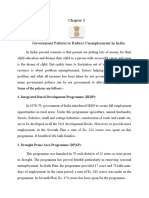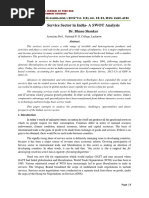Economic Impact of MGNREGA: A Micro-Case Study of Bisalpur Sub-Division of District Pilibhit in Uttar Pradesh
Economic Impact of MGNREGA: A Micro-Case Study of Bisalpur Sub-Division of District Pilibhit in Uttar Pradesh
Uploaded by
Mohammad MiyanCopyright:
Available Formats
Economic Impact of MGNREGA: A Micro-Case Study of Bisalpur Sub-Division of District Pilibhit in Uttar Pradesh
Economic Impact of MGNREGA: A Micro-Case Study of Bisalpur Sub-Division of District Pilibhit in Uttar Pradesh
Uploaded by
Mohammad MiyanOriginal Description:
Original Title
Copyright
Available Formats
Share this document
Did you find this document useful?
Is this content inappropriate?
Copyright:
Available Formats
Economic Impact of MGNREGA: A Micro-Case Study of Bisalpur Sub-Division of District Pilibhit in Uttar Pradesh
Economic Impact of MGNREGA: A Micro-Case Study of Bisalpur Sub-Division of District Pilibhit in Uttar Pradesh
Uploaded by
Mohammad MiyanCopyright:
Available Formats
International Journal of Pure and Applied Management Sciences;
2016 Vol. 1(1)
Economic Impact of MGNREGA: A Micro-Case Study of
Bisalpur Sub-division of District Pilibhit in Uttar Pradesh
Dr. Mohammad Israr Khan , **Savita Saxena*
*Assistant Professor, **Research Scholar,
Department of Applied and Regional Economics, MJP Rohilkhand University, Bareilly.
Date of revised paper submission: 07th June 2016; Date of acceptance: 21st July 2016
Date of publication: 14th August 2016; *First Author / Corresponding Author; Paper ID: MS16106
Abstract
Mahatma Gandhi National Rural Employment Act (MGNREGA) is a socio-economic law,
which was enacted for reducing poverty, unemployment, and hunger in India. It makes India a
country providing, for one hundred days, guaranteed unskilled wage employment to the unemployed
people, in rural areas, who come to ask for the same. This program is significantly different from the
earlier ones in that it gives guarantee for employment while the earlier wage employment programs
did not provide any such assured entitlement.
This paper tries to analyse the employment, income, and consumption effects via enhanced
purchasing power that can be ascribed to MGNREGA in the rural areas of the selected district. It
attempts to examine the social and economic as well as the assets creation impact of the scheme in
rural areas. Additionally, the paper evaluates rural womens empowerment in terms of employment,
income, and consumption brought about by MGNREGA which, in turn, is found to equip them with
these kinds of entitlements. The study concludes that MGNREGA induces a positive improvement in
the life of the people in the rural areas.
Keywords: Mahatma Gandhi National Rural Employment Act, Employment Guarantee, Rural
Development, Rural Asset Creation, Women Empowerment.
1. Introduction
India inhabits the second largest population set in the world with around two third of
the people living in rural areas and being dependent on agriculture and subsistence mode of economic
activities. Most of the rural families fail to fulfil essential needs. They remain below the poverty line.
They face many problems originating from the lack of employment. For it there is the only one
solution i.e. to provide employment in the rural areas. Government of India has been running many
poverty and unemployment alleviation programs such as TRYSEM, Jawahar Rojgar Yojana, Jawahar
Gram Smaridhi Yojana etc. These programs did not achieve success. So, to provide employment for
rural people, Government launched Mahatma Gandhi National Rural Employment Guarantee Act
(MGNREGA), 2005. It is a social law which was enacted for reducing poverty, unemployment and
hunger in India. Whereas earlier wage employment programs did not provide any guarantee of job,
this act provides for guaranteed employment. Additionally, it aims at improving the economic
condition of rural people by creation of durable assets.
1.1 Overview of MGNREGA
National Rural Employment Guarantee Act (2005) later renamed as
Mahatma Gandhi National Rural Employment Guarantee Act (MGNREGA) is one
of the most significant policy actions of the Government in post-Independent
P a g e | 52
International Journal of Pure and Applied Management Sciences;
2016 Vol. 1(1)
India. This act provides at least one hundred days of wage employment in a financial year to every
household whose adult members voluntarily do unskilled manual works. Under the act, employment
is to be provided within 5 km of an applicants residence, and minimum wages are to be paid under
the Minimum Wages Act 1948. If work is not provided within fifteen days of applying or receipt of
the application seeking employment or from date on which the employment has been sought in the
case of the advance application, applicants are entitled to an unemployment allowance. Thus,
employment under MGNREGA is a legal entitlement, guaranteeing one hundred days minimum
wage equivalence, with or without work.
Some of the original provisions of NREGA were as outlined below.
i.
ii.
iii.
iv.
v.
vi.
vii.
Every household in the rural areas of India shall have a right to at least 100 days of
guaranteed employment every year for at least one adult member, for doing manual work.
Only productive works shall be taken up under the Program. The State Council shall prepare
list of permissible works as well as a list of preferred works. The identification of the
preferred works shall be based on the economic, social and environmental benefits of the
different types of works, their contribution to the social equity and their ability to create
permanent assets.
The Program may also provide, as far as possible, for the training and up-gradation of the
skills of unskilled rural people.
Wages may be paid in the form of cash or in kind or both, taking into account the guidelines
and recommendations of the State Council on this matter as far as possible.
Employment shall be provided within the radius of 5 kilometres of the village where the
applicant resides at the time of applying. In cases where employment is provided outside such
radius, it must be provided within the Block, and transport allowances and daily living
allowances shall be paid in accordance with Program Rules.
In case where at least twenty women are employed on the worksite, a provision shall be made
for one of them to be deputed to look after any children under the age of six who may be
brought to the worksite, if the need arises. The person for child-minding shall be paid the
statutory minimum wage.
A proportion of the wages, not exceeding 5%, may be deducted as the contribution to welfare
schemes organized for the benefit of rural people employed under the Program, such as health
insurance, survivor benefits, accident insurance, maternity benefits and social security
schemes (National Rural Employment Guarantee Act, 2005).
MGNREGA is considered to be the largest and the most ambitious social security and public works
program in the world. Government of India has been running many poverty alleviation programs and
some success has also been achieved in the endeavour over the years. However, even today
Government struggles with the mass level of poverty and the unemployment related problems.
MGNREGA is a mixture of many policies and schemes such as Jawahar Rojgar Yojana, Right to
work, Food for work program, and Sampoorna Grameen Rojgar Yojana etc., as the forerunners to
MGNREGA. This act also provides employment for women and reserves one third of all employment
for them bringing, thereby, gender equality in the society via the provision of same sort of
employment to the males and females at the same wage rates and under similar conditions.
MGNREGA is implemented by Gram Panchayats (GPs) and State Governments with funds from the
Central Government. The main implementing agencies are the Gram Panchayats and involvement of
contractors is banned. GPs are to work as a safeguard to promote its effective management and
implementation. MGNREGA provides an alternative source of livelihood with a dampening impact on
poverty. It helps increase the purchasing power and expenditure of the beneficiaries, and helps village
P a g e | 53
International Journal of Pure and Applied Management Sciences;
2016 Vol. 1(1)
economies in gaining self-sustenance through productive assets creation such as road construction,
cleaning up of water tanks, soil and water conservation works etc. For these reasons, it has been
considered as the largest anti-poverty program in the world. However, the success of the act depends
upon its proper implementation.
There are the eight specific types of works listed in the NREGA i.e. (i) water conservation and water
harvesting; (ii) drought proofing including afforestation; (iii) irrigation canals; (iv) provision of
irrigation facility to land-owned by SC and ST, land of beneficiaries of land reforms and of Indira
Awaas Yojana (IAY) (rural housing for poor); (v) renovation of the traditional water bodies; (vi) land
development work; (vii) flood control related works; (viii) rural connectivity to provide all weather
access.
MGNREGA is thought of promoting economic growth and development. It directly targets poverty
eradication through creation of employment, training and creating asset endowments of the poor. The
present study attempts to examine the implementation procedures of MGNREGA and its economic
impact on the rural households.
1.2 Statement of the Problem
MGNREGA is one of the most ambitious centrally sponsored schemes of India. This
scheme has got success in the field of increasing income and expenditures, economic security, selftargeting, womens empowerment, assets creation, etc. How MGNREGA impacts all these
components is the central theme of the proposed study. The paper tries to know whether the people are
aware about MGNREGA work, whether the act is properly implemented, whether it provides one
hundred days of guaranteed wage employment to the entire eligible household population, and
whether it is successful in improving the purchasing power and expenditure levels of the rural
households.
Basically, the study attempts to find out the impact of MGNREGA on Socioeconomic and rural situation of the people. It aims at examining (a) the creation of rural assets and
infrastructure through MGNREGA; (b) the impact of the MGNREGA wages on the income and
expenditures of rural MGNREGA beneficiaries; and (c) the impact of MGNREGA on womens
empowerment in terms of employment income and consumption.
2. Literature Review
In August 2005, National Rural Employment Guarantee Act was legislated to provide
guaranteed employment to rural people in India. Several studies have been conducted by the
government and non-government agencies and researchers, since then. Pant & Mishra (2014)
concluded that MGNREGA promotes transparency, accountability and involvement of local
organizations, the act mandates monthly squaring of accounts. To ensure the public accountability
through public vigilance, NREGA designates social audits as the key to its implementation. Annual
Report of the Ministry of Rural Development (2006-07) stated that in case of choice of work under
NREGA, highest priority (i.e. 54%) was given to water conservation followed by providing irrigation
facility to the land owned by SC/ST (10%), the land development (11%), the rural connectivity (21%),
and any other activity 4% in 2006-2007.Annual Report (2008-09) of the same ministry revealed that
that 67% of the funds were utilized in the form of wages paid to the labour. The program had high
work participation for marginalized groups like SC/ST (54%) and women 48%. Moreover, it
strengthened the natural wage, of which 46% were soil conservation 18% rural connectivity, 50% land
development, 20% irrigation work on individual beneficiaries.
P a g e | 54
International Journal of Pure and Applied Management Sciences;
2016 Vol. 1(1)
A study on the process and mechanism of MGNREGA by Pankaj (2008) assessed the
impact of the scheme in Bihar and Jharkhand. It reported that works of water conservation and
harvesting, irrigation and rural connectivity constitute the bulk of schemes undertaken in Jharkhand
and Bihar states. The nature of works undertaken in various district of these two states suggested that
the MGNREGA can contribute significantly to the creation of much needed infrastructure.
Chaurashia (2011) observed that MGNREGA has changed the direction and position
of women; women are working outside except domestic works. NREGA has the potential for
womens empowerment by providing them opportunities for paid work. The fact that one third of all
employment is reserved for women can promote gender equality in the society. Chandrasekhar and
Ghosh (2009) also observed that MGNREGA is also a scheme of social inclusion because the
marginalized sections of society have high percentage of participation under this act. The participation
rate of Scheduled castes (SC) and Scheduled Tribes (ST) in 2009-10 was 52% and around one-third of
the stipulated work force was women.
Dey and Bedi (2010) studied functioning of NREGS between February 2006 and July
2009 in Birbhum district, West Bengal. Their study reveals that in order to serve as an effective
employer of last resort, the program should provide the more job days during lean season and the
wages should be paid in a timely manner. This study found, in the selected areas, universal awareness
about the NREGS, job card have been made available to those who have applied and the NREGS
related information is well maintained and relatively accessible. But there are long delays in wage
payments during the first year of the program, since then, the payment lag has declined and it is now
in the range of 20 days. Khera (2008) observed that the successful implementation of the NREGA in
the Pati block in Orissa state goes beyond the ability of its residents to claim their rights. This is
brought out by the high levels of engagement with the program in terms of planning, implementation
and monitoring. Apart from its immediate aim of being a form of social security for the rural poor, by
providing them the local employment, it was expected that NREGA would contribute to activating
Gram Sabhas, empowering women and developing rural areas. In this sense, the organization studied
by the author in Madhya Pradesh has fully imbibed the spirit of MNREGA, where it is looked upon as
an opportunity to promote the overall development of village as well as to alter the balance of the
power in the village society.
Mathur (2008) asserted that MGNREGA could act as a great agent of socio-economic
up-lift by providing livelihood security poorest of the poor in India, if implemented earnestly. Basu
(2011) studied impact of MGNERGA on seasonal employment. This study models the impact of such
employment guarantee schemes in the context of an agrarian economy characterized by lean season
involuntary unemployment as a consequence of tied labour contracts. It examined labour and output
market responses to a productive rural Employment Guarantee Scheme (EGS) and determined the
optimal compensation to public work employees consistent with the objectives of (i) productive
efficiency in agriculture and (ii) welfare maximization of the labour. The authors framework
provided a theoretical one for the evaluation of a number of (sometimes) conflicting observations and
empirical results on the impact of an EGS on agricultural wages, employment and output, and
underscored the importance of the relative productivity of workers in the EGS program vis--vis their
counterparts engaged in the agricultural production in determining success of these programs. Dey et
al. (2006) opined that NREGS is totally a different scheme. It is an important initiative in the direction
of poverty alleviation. This scheme could be implemented in powerful order. The Scheme is different
from others employment-guarantee schemes like employment insurance scheme and Jawahar Rojgar
P a g e | 55
International Journal of Pure and Applied Management Sciences;
2016 Vol. 1(1)
Yojana (JRY) because in other schemes people have not any paradigms so they do not have the power
and in others there is also no accountability of the Administration.
Dasgupta and Sudarshan (2011), using data from the 200405 NSSO survey and
NREGA official sites, found that: (i) womens participation in the NREGA has been increasing; (ii)
state wise womens participation in the program is positively correlated with womens participation in
rural areas, though womens participation in NREGA is often higher than in other forms of recorded
work so far; and (iii) womens participation is the negatively correlated with existing gender wage gap
in unskilled agricultural labour. The later implies that where womens actual wages as the share of
mens is lower in the private sector, women are flocking to work in this government administered
program. This will inevitably raise womens bargaining power being potentially a critical factor in
reducing gender disparities in the labour market.
3. Observation Based Analysis and Discussion
This paper is based on primary observation and secondary data. Observation schedule
was prepared and responses of the MGNREGS beneficiaries were recorded accordingly. The
respondents were contacted on the worksite.87% respondents were men and on the other hand 13 %
were women. The responses and observations are discussed below.
Table 1: Responses obtained from the MGNREGA Beneficiaries
S.
No.
Questions/Variables
Yes
No
1. Are you aware about MGNREGA scheme of the government?
79
21
2. Do you have job card?
100
3. Any problem did you face in getting job card?
100
4. Do you have an account in bank/post office relating to MGNREGA?
100
5. Are you involved in MGNREGA planning?
81
19
6. How much wages do you get under MGNREGA scheme?
161 Rupees.
7. Did you get work against demand?
86
8. If yes, after how many days of written/verbal application did you get
work?
Within
days
9. Did you get 100 days of guaranteed wage employment under
MGNREGA?
44
56
10. Do you feel an increase in your income and expenditures, due to
MGNREGS?
74
26
14
15
P a g e | 56
International Journal of Pure and Applied Management Sciences;
2016 Vol. 1(1)
11. Has MGNREGA improved the condition of women in your household?
87
13
12. Has MGNREGA eased the problem of unemployment?
92
13.Do you get the unemployment allowance?
100
14.Has MGNREGS augmented common infrastructure and assets in your
village?
81
19
15.Does MGNREGA need improvements?
100
(Source: Field Survey)
3.1 Awareness and Implementation: It was found that all the respondents knew about MGNREGA
scheme. 79% respondents had detailed knowledge of MGNREGA. They told that MGNREGA is a
social act by which one hundred days of wage employment are provided to them and besides it many
facilities been provided on the worksite of MGNREGA. On the other hand, 21% respondents did not
have any knowledge of MGNREGA scheme because of their literacy.
Workers Involvement: It was found that 81% people were involved in MGNREGA planning. They
got guaranteed wage employment because they were aware about MGNREGA planning. On the other
hand, 19% respondents were not involved in MGNREGA plans. There is a need for the programme
planning and execution to be universally participatory.
Unemployment Allowance: Unemployment allowance means if an applicant demands work against
under this act but employment is not provided within fifteen days of the receipt of this application
seeking employment then the person shall be entitled to a daily unemployment allowance under the
provisions of the act. Here in the selected areas, it was found that nobody knew about unemployment
allowance because they had lack of knowledge information. Nobody was found to have got an
unemployment allowance.
3.2 Process and Procedure:
Job Card Availability: Here on the worksite of MGNREGA, all the respondents have job cards and
they replied they did not face many problems in getting job cards. In the survey, the people were not
interviewed who have not job cards.
Wages and Works: Here the beneficiaries of MGNREGA told that they get wages at Rs. 161 rupees
per day under this act. Again they answered that when they want to do work they have got the
employment against demand only by verbal request. They have not given any written application to
Rojgar Sevak. They also said that they got work within fifteen days after the request.
One Hundred Days of Employment: It was found in the selected areas that MGNREGA provided
one hundred days of wage employment in a financial year to the adult members who willed to do
unskilled manual work at the statutory Rs.161 per day minimum wages.
3.3 Economic Impact
Financial Inclusion: It was found that all the respondents had accounts in bank/ post office related to
MGNREGA. In this way MGNREGA is considered a way of financial inclusion.
P a g e | 57
International Journal of Pure and Applied Management Sciences;
2016 Vol. 1(1)
Effects on Income and Expenditures: MGNREGA positively impacts the rural households. 74%
respondents replied that their income was increased and then purchasing power and expenditures also
increased because of MGNREGA. It is a market-demand inducing scheme because their increased
income creates a demand for the output and their propensity to consume increases. MGNREGA brings
economic growth as well as economic development. They again said that they can live better life
standard and fulfil their necessary goods of life. While on the other hand 26% respondents replied to
this question in negative. In this way it has been seen that MGNREGA is only partially successful in
increasing the income, purchasing power, and expenditures of rural households.
MGNREGA Eases Unemployment: MGNREGA has helped ease the problem of unemployment. By
provided one hundred days of guarantee wage employment to the rural household. It is a big
contribution to unskilled wage employment at a large scale in the rural areas of the country.
3.4 Women Empowerment: MGNREGA helped to improve the condition of rural women and helped
them become empowered whereby they can live on their own. They can live better life and fulfil their
necessary goods of life and they can also give better education to their children. In this way
MGNREGA is helpful to them who work on worksite of MGNREGA.
3.5 Creation of Assets and Infrastructure: In the field survey of selected areas it was found that
many permanent and temporary assets were created in the chosen Gram Panchayats such as road
connectivity, water harvesting, tree plantation, conservation of soil etc. Because of that infrastructure
in rural areas was developed. Resultantly, MGNREGA has helped rural areas via creation of common
assets and infrastructure development.
3.6 Need for Improvements: It was found that nobody was fully satisfied with the existing form of
this program. They desired improvement in MGNREGA. It has many shortcomings such as lack of
transparency and accountability as well as unequal treatment to the people on the basis of social and
political realities.
Most of the respondents under observation had taken advantage of MGNREGA scheme. It was also
noticed that MGNREGA is a demand oriented scheme because of this its beneficiaries purchasing
power is increased and their life standard goes up such as health improvement, good education, etc.
and in such a way their demand for commodities is increased. Thus, economic development is also
increased and it can be said that MGNREGA is helpful to economic development. It can be deduced
that MGNREGA could be an important vehicle for inclusive growth because of the gainful
participation of the marginalized sections of society.
4. Findings
The study found that MGNREGA has positively impacted the both the rural people
and rural areas. Many assets are created in these selected Gram Panchayats such as water
conservation, water harvesting, tree plantation, conservation of soil, renovation of traditional water
bodies, land development, rural connectivity and flood control works etc. Because of MGNREGA,
not only the Gram Panchayats are developed but also the rural people have got guaranteed
employment. MGNREGA work also could be a big help for such families who are small and marginal
farmers, depending mostly on the farming income, having only one earning member. MGNREGA
work could supplement their incomes and raise their standard of consumption. MGNREGA is a boon
for the rural households because it provides the guaranteed employment for the rural people for their
spare time because of that one side they have got employment and another side their income is
increased. When income is increased because of it their purchasing power and expenditures are
increased. The life standard of rural people also goes up because of MGNREGA.
P a g e | 58
International Journal of Pure and Applied Management Sciences;
2016 Vol. 1(1)
This study found the evidence that rural women are feeling empowered and equal of
men. MGNREGA work did not discriminate between the men and women in terms of their wages.
This fact was the most significant confidence boost up for women. During the survey, most of the
women on the worksite of MGNREGA said that the life standard of them has been grown up, they can
fulfil the essential needs of their life from own wages and without men because of MGNREGA.
Before MGNREGA, they did not enjoy such opportunities to do work equally like the males and
remained only as the walled housewives. MGNREGA is the first act which has given these important
provisions under which the rural women feel much better.
5. Conclusion
It is a well-established economic fact that spending has a multiplier effect. When
these poor households spend their additional MGNREGA money, they create a demand for several
commodities. The production of these commodities, in turn, creates demand for raw material and
workers thus creating a spiral of growth linkages. The study found that the majority of the families
were spending the increased income from MGNREGA after better food basket followed by childrens
education and health. It shows that the MGNREGA money is being spent after improving the quality
of life and human development related issues.
6. Conflict of Interest
There is no conflict of interest of any of the authors. However, the second author is accountable for
data accuracy, reliability, and citation related integrity.
References
1. Annual Report. Ministry of Rural Development, (April 2006-March 2007). GOI: New Delhi.
2. Annual Report. Ministry of Rural Development, (April 2008-March 2009). GOI: New Delhi.
3. Basu, A. K., 2011; Impact of Rural Employment Guarantee Schemes on Seasonal Labour
Markets: Optimum Compensation and Workers Welfare, Journal of Economic Inequality,
US: Springer.
4. Chandrasekhar, C. P., Ghosh, J., (January 2009). Social inclusion in the NREGS. Business
line.As quoted in Indian Economy, (eds.) SK Mishra and VK Puri, Himalaya Publishing
House. Pp 186-190.
5. Chaurashia, D., 2011; Empowered Women from Employment and Health Deficiency,
Ministry of Rural Development, New Delhi. Pp.161.
6. Dasgupta, S., Sudarshan, S., 2011; Issues in Labour Market Inequality and Womens
Participation in Indias National Rural Employment Guarantee Act, Working Paper No. 98.
Geneva: ILO.
7. Dey, S. and Bedi, A., 2010; The National Rural Employment Guarantee Scheme in Birbhum,
Economic and Political Weekly, XLV (41).Pp 19-25.
8. Dey, N., Dreze, J., Khera, R., 2006; Employment Guarantee Act: A Primer. New Delhi:
National Book Trust.
9. Khera, R., 2008; Employment Guarantee Act, EPW, vol. 43. Pp. 35-30.
10. Mathur, L., 2008; Employment Guarantee: Progress so far. EPW vol. 52, Dec. 29, 2007
Jan. 4, 2008. Pp. 17-20.
11. Pankaj, A. K., 2008; Process, Institution and Mechanism of Implementation MGNREGA:
Impact Assessment Report of Bihar and Jharkhand.
12. Pant, J. C., Mishra, J. P., 2014; Indian Economic Difficulties. Sahitya Bhavan Publication.
Agra.
P a g e | 59
You might also like
- Cito Mock Exam Ipma Level D Open Questions AnswersDocument7 pagesCito Mock Exam Ipma Level D Open Questions Answerszagorje1230% (1)
- Real-Life BPMN - Edition 4Document229 pagesReal-Life BPMN - Edition 4Mathias Nielsen100% (2)
- ESD - QuizizzDocument17 pagesESD - QuizizzHoda FakourNo ratings yet
- Sicilian O'Kelly VariationDocument21 pagesSicilian O'Kelly VariationJuan Andres Auernheimer100% (2)
- Gospel of ThomasDocument6 pagesGospel of ThomasMariaNo ratings yet
- Mahatma Gandhi National Rural Employment Guarantee SchemeDocument65 pagesMahatma Gandhi National Rural Employment Guarantee SchemeSaroj KumarNo ratings yet
- 1) Introduction: Act (MGNREGA) Is An Indian Law That Aims To Guarantee The 'Right ToDocument37 pages1) Introduction: Act (MGNREGA) Is An Indian Law That Aims To Guarantee The 'Right ToShree CyberiaNo ratings yet
- Critical Analysis of The Mahatma Gandhi National Rural Employment Guarantee Act MgnregaDocument5 pagesCritical Analysis of The Mahatma Gandhi National Rural Employment Guarantee Act MgnregaBANDANA SAIKIANo ratings yet
- Mahatma Gandhi National Rural Employment Guarantee ActDocument13 pagesMahatma Gandhi National Rural Employment Guarantee ActVlk WldNo ratings yet
- Rural Employment Generation in India Through Mahatma Gandhi National Rural Employment Guarantee Scheme (MGNREGS)Document10 pagesRural Employment Generation in India Through Mahatma Gandhi National Rural Employment Guarantee Scheme (MGNREGS)georgiaNo ratings yet
- NaReGa English PDFDocument81 pagesNaReGa English PDFVickram JainNo ratings yet
- Mahatma Gandhi National Rural Employment GuaranteeDocument24 pagesMahatma Gandhi National Rural Employment GuaranteePragyan NibeditaNo ratings yet
- MGNEREGA and Rural DevelopmentDocument5 pagesMGNEREGA and Rural DevelopmentAmit kumarNo ratings yet
- Report On MGNAREGA SchemeDocument23 pagesReport On MGNAREGA SchemeSaurabh RathodNo ratings yet
- Mahatma Gandhi National Rural Employment Guarantee ActDocument7 pagesMahatma Gandhi National Rural Employment Guarantee ActHrishikeshNo ratings yet
- Mahatma Gandhi National Rural Employment Guarantee Ac1-1Document10 pagesMahatma Gandhi National Rural Employment Guarantee Ac1-1maneeshamberNo ratings yet
- National Rural Employment Guarantee Act, 2005Document17 pagesNational Rural Employment Guarantee Act, 2005praharshithaNo ratings yet
- AHS 546B (UNIT2) Sakshi Garg MSC 4thDocument5 pagesAHS 546B (UNIT2) Sakshi Garg MSC 4thSakshi GargNo ratings yet
- Mahatma Gandhi National Rural Employment Guarantee ActDocument16 pagesMahatma Gandhi National Rural Employment Guarantee ActVinod Thomas EfiNo ratings yet
- The Big Picture 10 Years of MGNREGA How Successful - 3Document2 pagesThe Big Picture 10 Years of MGNREGA How Successful - 3shiv161No ratings yet
- Poverty Alleviation Programmes - Tnpsctamil.inDocument10 pagesPoverty Alleviation Programmes - Tnpsctamil.inPrakash SundaramNo ratings yet
- Project MGNREGS-2Document8 pagesProject MGNREGS-2keerthanaprakashan77No ratings yet
- Law and Economics Project FinalDocument13 pagesLaw and Economics Project FinalShivechchha SinghNo ratings yet
- Vulnerable Workers: Igrant OrkersDocument10 pagesVulnerable Workers: Igrant OrkersKanishq BawejaNo ratings yet
- ROR projectDocument19 pagesROR projectvirkangad085No ratings yet
- IMPGovt SchemesDocument19 pagesIMPGovt Schemesgsaumya262No ratings yet
- Introduction To MgnregaDocument7 pagesIntroduction To MgnregaBabagouda Patil100% (1)
- BhenchodDocument7 pagesBhenchodHrishikeshNo ratings yet
- Concise Report Final Corrected 02.01Document103 pagesConcise Report Final Corrected 02.01Alok JainNo ratings yet
- Untitled documentDocument10 pagesUntitled documentkeerthanaprakashan77No ratings yet
- Mahatma Gandhi National Rural Employment Guarantee Act (Mgnrega) : A Reality or RhetoricDocument16 pagesMahatma Gandhi National Rural Employment Guarantee Act (Mgnrega) : A Reality or Rhetoricjairaj_rathore12100% (1)
- National Rural Employment Guarantee ActDocument17 pagesNational Rural Employment Guarantee ActRehan SiddiquiNo ratings yet
- Rural Development Seminar Paper: TOPIC: MGNREGA and Its Contribution Towards Poverty AlleviationDocument11 pagesRural Development Seminar Paper: TOPIC: MGNREGA and Its Contribution Towards Poverty AlleviationAPOORVA BALAKRISHNANNo ratings yet
- Mgnrega ThesisDocument7 pagesMgnrega Thesisgbtrjrap100% (2)
- Collaborative Governance Analysing Social Audits in MGNREGA in IndiaDocument7 pagesCollaborative Governance Analysing Social Audits in MGNREGA in IndiaVENKY KRISHNANo ratings yet
- SustainDocument7 pagesSustainSHUBHANGI CHOWDHURYNo ratings yet
- Poverty Alleviation Programmes in IndiaDocument6 pagesPoverty Alleviation Programmes in IndiaMohana Ramasamy100% (1)
- MGNREGA and Rural Distress in IndiaDocument10 pagesMGNREGA and Rural Distress in IndiainventionjournalsNo ratings yet
- Ecoo Proooo NewwDocument14 pagesEcoo Proooo Newwayush singhNo ratings yet
- Mahatma Gandhi National Rural Employment Guarantee Act - Wikipedia, The Free EncyclopediaDocument3 pagesMahatma Gandhi National Rural Employment Guarantee Act - Wikipedia, The Free Encyclopediasubho21mukherjee4076100% (3)
- NREGA Report FinalDocument13 pagesNREGA Report FinalAmit YadavNo ratings yet
- MNREGA and NRHMDocument5 pagesMNREGA and NRHMAnusha SawhneyNo ratings yet
- Impact of MGNREGA On Socio-Economic Development& Women EmpowermentDocument4 pagesImpact of MGNREGA On Socio-Economic Development& Women EmpowermentIOSRjournalNo ratings yet
- National Rural Employment Guarantee ActDocument14 pagesNational Rural Employment Guarantee Actmamatarane0207No ratings yet
- Government Policies To Reduce Unemployment in India ReportDocument7 pagesGovernment Policies To Reduce Unemployment in India Reportketan bhereNo ratings yet
- Origin of NregaDocument3 pagesOrigin of NregaMayank Sharma100% (3)
- Poverty and Social SectorDocument9 pagesPoverty and Social SectorsurreddNo ratings yet
- Preface: Appraisal of Gram Panchayat Under MGNREGADocument15 pagesPreface: Appraisal of Gram Panchayat Under MGNREGAshoyeb_mohmmedNo ratings yet
- NREGA IntroductionDocument10 pagesNREGA Introduction9600620990No ratings yet
- MGNREGA and Its Effects On Indian EconomyDocument5 pagesMGNREGA and Its Effects On Indian EconomyAadya SinghNo ratings yet
- Government Policies To Reduce Unemployment in India ReportDocument7 pagesGovernment Policies To Reduce Unemployment in India ReportRizwan AkhtarNo ratings yet
- 4B. MnregaDocument6 pages4B. MnreganamanNo ratings yet
- Model Project 1Document67 pagesModel Project 1Dharmesh Deshmukh50% (2)
- Labour LawDocument17 pagesLabour LawAtharv AnandNo ratings yet
- MGNREGADocument5 pagesMGNREGAFizzah JawedNo ratings yet
- Thesis On NregaDocument7 pagesThesis On Nregagj9ggjry100% (2)
- Unemployment ArticleDocument7 pagesUnemployment Articledeepthi k thomasNo ratings yet
- EcooooooooooDocument10 pagesEcooooooooootamannaNo ratings yet
- NREGA Report FinalDocument13 pagesNREGA Report FinalPraful KularkarNo ratings yet
- Poverty Alleviation Programmes in IndiaDocument16 pagesPoverty Alleviation Programmes in Indianeha100% (1)
- Narega FinalDocument40 pagesNarega Finala.awari2024No ratings yet
- IndiaMGNREA ENDocument11 pagesIndiaMGNREA ENajitm453No ratings yet
- AgwagesDocument49 pagesAgwagesSarikaNo ratings yet
- Efficacy of Leadership Ethics As A Tool For Developing Capabilities: A Study On Mba StudentsperspectivesDocument12 pagesEfficacy of Leadership Ethics As A Tool For Developing Capabilities: A Study On Mba StudentsperspectivesMohammad MiyanNo ratings yet
- The Socio-Economic Conditions of Tribal Communities in IndiaDocument7 pagesThe Socio-Economic Conditions of Tribal Communities in IndiaMohammad Miyan100% (1)
- Statistical Review On The Nationalized Banks in IndiaDocument12 pagesStatistical Review On The Nationalized Banks in IndiaMohammad MiyanNo ratings yet
- Service Sector in India - A SWOT AnalysisDocument12 pagesService Sector in India - A SWOT AnalysisMohammad Miyan0% (1)
- Indian Pharmaceutical Industry - A GenesisDocument7 pagesIndian Pharmaceutical Industry - A GenesisMohammad MiyanNo ratings yet
- An Analysis of Government Tax Revenue in IndiaDocument4 pagesAn Analysis of Government Tax Revenue in IndiaMohammad MiyanNo ratings yet
- The Poetry of Jayanta Mahapatra: A Post Colonial PropositionDocument7 pagesThe Poetry of Jayanta Mahapatra: A Post Colonial PropositionMohammad MiyanNo ratings yet
- Effective Monitoring of Vehicular PollutionDocument4 pagesEffective Monitoring of Vehicular PollutionMohammad MiyanNo ratings yet
- Obstacles in Teaching English As A Second Language (Esl) Among Pre-University Students of District Mianwali (Pakistan) - A Pakistani Case StudyDocument11 pagesObstacles in Teaching English As A Second Language (Esl) Among Pre-University Students of District Mianwali (Pakistan) - A Pakistani Case StudyMohammad MiyanNo ratings yet
- Sebi: A Directive Hand For Capital Markets Vivek Kumar TiwariDocument7 pagesSebi: A Directive Hand For Capital Markets Vivek Kumar TiwariMohammad MiyanNo ratings yet
- Glovia Information 2018-04-18Document3 pagesGlovia Information 2018-04-18Amol AgteNo ratings yet
- Corcote HCR FFDocument4 pagesCorcote HCR FFRase Valdivia YacilaNo ratings yet
- Seatwork 08SW01Document8 pagesSeatwork 08SW01airamNo ratings yet
- Mudra Solution Company ProfileDocument5 pagesMudra Solution Company Profilekedarravidas05No ratings yet
- Grade 12 - Media and Information Literacy: First Quarter Week 1 Day 01Document12 pagesGrade 12 - Media and Information Literacy: First Quarter Week 1 Day 01Ginalyn QuimsonNo ratings yet
- Lecture #19: Moments of InertiaDocument19 pagesLecture #19: Moments of InertiaAfiqah ZainuddinNo ratings yet
- Project Development Office III (Learning and Development Officer)Document1 pageProject Development Office III (Learning and Development Officer)Office of the Presidential Adviser on the Peace ProcessNo ratings yet
- Catalogo-Juwel 2014Document28 pagesCatalogo-Juwel 2014Giordano BenicchiNo ratings yet
- LT SYstem Wiring ComponentsDocument35 pagesLT SYstem Wiring Componentsenglishtv52No ratings yet
- Bsit It3118-MidtermDocument25 pagesBsit It3118-MidtermBeerusNo ratings yet
- Spesifikasi KOMATSU WA200-6Document12 pagesSpesifikasi KOMATSU WA200-6Muhammad SyahmiNo ratings yet
- Dr. Chaitanya Sharma Phd. Iit RoorkeeDocument26 pagesDr. Chaitanya Sharma Phd. Iit RoorkeeTrung Quoc LeNo ratings yet
- Optical FibreDocument8 pagesOptical Fibremoresurya87No ratings yet
- Unit 10 Merits and Demerits of Fixed and Flexible Foreign Exchange Rates. Merits of Fixed Exchange RateDocument2 pagesUnit 10 Merits and Demerits of Fixed and Flexible Foreign Exchange Rates. Merits of Fixed Exchange RateSenthil Kumar GanesanNo ratings yet
- Aceite Transformador Calumet-Caltran N60-30Document7 pagesAceite Transformador Calumet-Caltran N60-30Wualdir Vivas ChungaNo ratings yet
- Chapter 25 - Survey Methods For Network DataDocument36 pagesChapter 25 - Survey Methods For Network DataPricsantosNo ratings yet
- Present A Mail-Bid Auction of Orders, Decorations and Medals of The World Closing at 5pm, Pacific Time, 1 March 2012Document89 pagesPresent A Mail-Bid Auction of Orders, Decorations and Medals of The World Closing at 5pm, Pacific Time, 1 March 2012Noriel RosanaNo ratings yet
- Dps Mathura Road Holiday Homework 2014Document6 pagesDps Mathura Road Holiday Homework 2014g3rzcx36100% (1)
- Navgrahas Remedies - VariousDocument2 pagesNavgrahas Remedies - VariousSuresh SrinivasanNo ratings yet
- Circle-II - (Section ABCD) - JEE-21 (3 Yr Int) - Final-9-5-20Document9 pagesCircle-II - (Section ABCD) - JEE-21 (3 Yr Int) - Final-9-5-20Ved NarsekarNo ratings yet
- Madeviral - Social Media Management ServicesDocument12 pagesMadeviral - Social Media Management ServicesBombom WillkinsonNo ratings yet
- Class 12 Psychology Ncert Notes Chapter 1Document43 pagesClass 12 Psychology Ncert Notes Chapter 1pavani.chugh.3175No ratings yet
- Introducti 11Document21 pagesIntroducti 11Uzma SiddiquiNo ratings yet
- MODULE 4 5 Nav Watch 2Document8 pagesMODULE 4 5 Nav Watch 2Faith MagluyanNo ratings yet
- Vulnerability Assessment and Penetration Testing For Cyber DefenceDocument3 pagesVulnerability Assessment and Penetration Testing For Cyber DefencemugilanitNo ratings yet



















